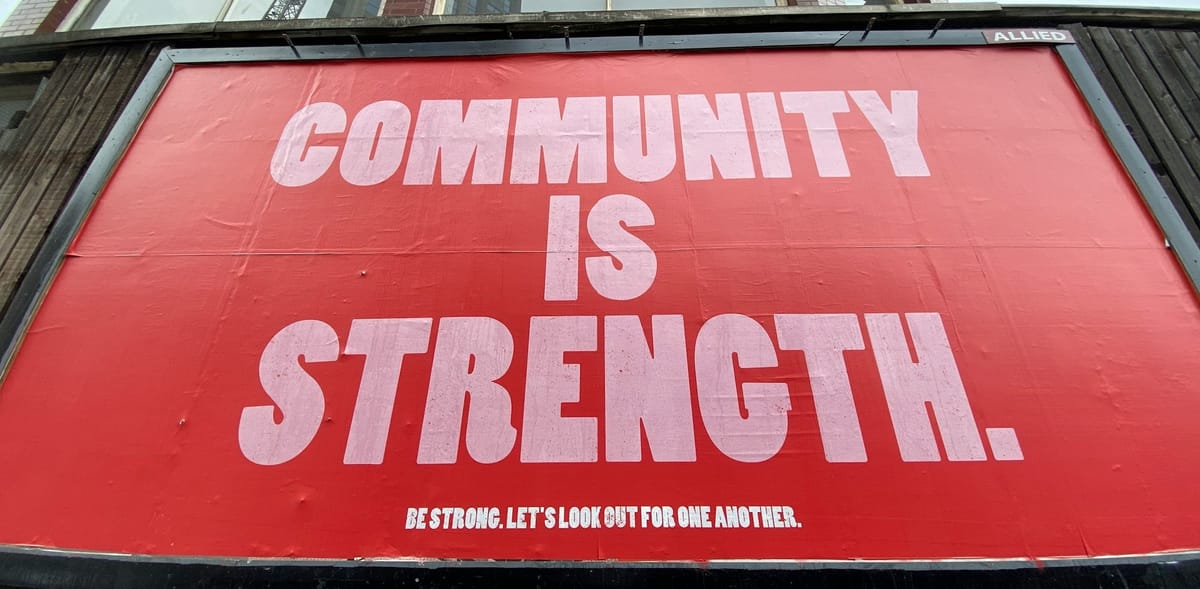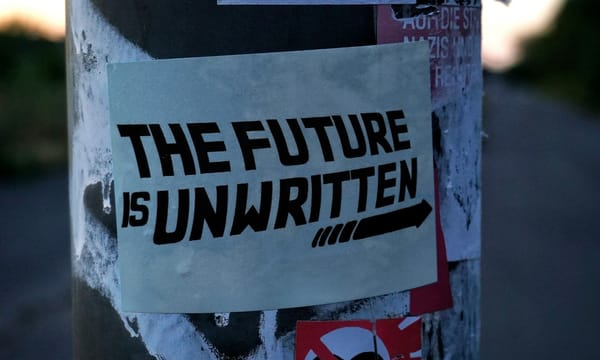How to Build Parallel Infrastructure in a Collapsing Democracy
From the Zapatista autonomous zones in Mexico, to the Black Panther Party’s community programs in the U.S., to the Kurdish councils of Rojava, parallel infrastructure has always been the scaffolding of liberation.

What Is Parallel Infrastructure (And Why We Need It Now)
When a democracy collapses, it rarely does so all at once. The courts may still function, but only for the loyal. The hospitals are open, but care is rationed. Food still arrives—until it doesn’t. And in the spaces where the state once served the public, a chilling void grows.
That’s where parallel infrastructure comes in.
Parallel infrastructure is the network of alternative systems that communities create outside of or alongside the state when the official channels become hostile, unreliable, or violent. It’s the food bank when the shelves are empty. The neighborhood watch when the police become occupiers. The encrypted network when the press is silenced. The underground clinic when reproductive care is criminalized.
It is not a utopian fantasy.
It is survival architecture.
Authoritarian regimes fear parallel infrastructure because it proves the state is not inevitable. It exposes that another way is possible and it functions as both resistance and lifeline.
Throughout history, communities have built shadow systems in response to collapse, war, occupation, and dictatorship. From the Zapatista autonomous zones in Mexico, to the Black Panther Party’s community programs in the U.S., to the Kurdish councils of Rojava, parallel infrastructure has always been the scaffolding of liberation.
It is:
- Built under pressure,
- run by everyday people,
- and adaptable to the terrain of collapse.
We don’t need permission to begin. We need coordination, courage, and a refusal to wait for permission from the systems that are actively abandoning us.
Real-World Examples from the U.S. and Around the World
Parallel infrastructure is already happening, it isn't theoretical. All around the world, people have responded to violence, abandonment, and collapse by building new systems when the old ones broke. Some of these efforts were grassroots. Some were revolutionary. All were born from necessity. These aren’t just stories of survival. They’re proof of concept.
1. Mutual Aid Networks – United States (2020–Present)
At the height of the COVID-19 pandemic, while federal agencies flailed and states hoarded resources, thousands of decentralized mutual aid groups sprang up overnight. Neighbors organized WhatsApp chats. Strangers delivered food and prescriptions to the immunocompromised. People printed zines on how to sterilize gear and survive eviction.
This was not charity. It was infrastructure built by the people for the people—faster, more agile, and more trusted than the state.
“When the government failed, mutual aid saved lives.”
2. The Zapatista Autonomous Zones – Chiapas, Mexico
In 1994, the Zapatistas (EZLN), an Indigenous-led revolutionary movement, declared autonomy from the Mexican state. Since then, they’ve built parallel infrastructure across dozens of communities:
- Independent schools
- Women-run health clinics
- Collective farming and food distribution
- Democratic councils that replace state bureaucracy
Their model is anti-capitalist, anti-colonial, and enduring because it’s grounded in lived community need, not imposed ideology.
3. CHAZ / George Floyd Autonomous Zone – United States (2020)
During the George Floyd uprising, protestors in Seattle temporarily took over several city blocks, forming the Capitol Hill Autonomous Zone (CHAZ). Though short-lived, it functioned as a proof-of-concept space: no police, no formal governance, yet mutual care thrived.
There were:
- Free kitchens
- Med tents
- A no-cop conflict de-escalation crew
- Community teach-ins and political discussion spaces
Despite media fearmongering, CHAZ was a glimpse of life beyond carceral logic.
4. Rojava (Northeast Syria) – Kurdish Revolutionary Infrastructure
In the chaos of the Syrian civil war, Kurdish forces seized a rare opportunity: to create a stateless society based on feminism, ecology, and direct democracy. Despite being under constant threat from Turkey, ISIS, and the Assad regime, Rojava:
- Runs women-led governing councils
- Practices community defense via militia-based popular assemblies
- Promotes grassroots education and multilingual cultural preservation
It’s one of the boldest examples of parallel infrastructure under siege and still surviving.
5. The Black Panther Party – United States (1966–1980s)
Forget the fearmongering—what terrified the U.S. government most about the Panthers wasn’t their guns. It was their ability to govern.
They ran:
- Free breakfast programs
- Medical clinics
- Sickle cell testing services
- Political education for adults and youth
J. Edgar Hoover called their community programs “the greatest threat to the internal security of the United States.”
That wasn’t paranoia. It was recognition: They had the blueprint.
6. West Bank Grassroots Infrastructure – Palestine
In the face of occupation, displacement, and apartheid, Palestinian communities have built:
- Underground health clinics
- Mutual aid supply chains
- Smuggling routes for banned medications
- Cultural resistance hubs (theater, poetry, storytelling)
Where the Israeli military enforces brutality and the Palestinian Authority fails to protect, the people protect each other.
These examples prove that parallel infrastructure is more than a luxury, it’s a survival necessity. And whether it’s built under martial law or in the shadow of neglect, one truth repeats:
When the state collapses, the people rise.
What to Build (Infrastructure Types)
You don’t need to be a revolutionary to start building infrastructure. You need only a clear understanding of what’s collapsing and what’s needed in its place.
Parallel infrastructure isn’t about replicating the state. It’s about meeting urgent needs with community-led systems that are resistant to authoritarian capture. Whether you’re in a city, suburb, or rural zone, these are the foundational categories of resistance infrastructure you can begin developing today:
1. Food Systems
Authoritarian regimes often control people through scarcity. Food deserts, inflated prices, and rationing programs can become tools of loyalty enforcement. A resilient resistance movement builds food systems that cannot be easily choked.
Start with:
- Community gardens (especially on land not easily surveilled or regulated)
- Guerrilla planting (edible crops in public or abandoned spaces)
- Collective kitchens (shared prep, distribution, and supply pooling)
- Food cooperatives and bartering circles
- Emergency shelf-stable food networks with hidden stashes
2. Medical Care
As healthcare becomes privatized, criminalized, or militarized, people die from preventable conditions—not from lack of medicine, but from lack of access.
Build:
- Underground reproductive health networks (abortion doulas, Plan B distribution, telemedicine allies)
- Trauma-informed first-aid training and kits
- Mobile clinics that rotate between trusted locations
- Networks of sympathetic or clandestine providers
- Mental health mutual aid (burnout circles, crisis rotation partners, grief counselors)
3. Communications & Information Infrastructure
Censorship doesn’t always start with bans, it starts with noise, confusion, and dependency on state-controlled narratives.
Protect information by creating:
- Mesh networks that function without internet (e.g., goTenna, disaster.radio)
- Offline zine printing and flyer networks
- Signal groups with safety protocols and code names
- Emergency broadcast radios
- Fireproof archives of banned or vulnerable knowledge
Also, teach people how to recognize psy-ops, AI-generated propaganda, and manipulated media.
4. Defense & Safety
I'm not talking about vigilante violence. I'm referring to community protection when police become enforcers of the regime.
Consider:
- De-escalation and rapid response teams for ICE raids, street harassment, or protest fallout
- Signal-based alert systems (e.g. flare groups, burner phone trees)
- Safe houses or “rest zones” for targeted individuals
- Protest marshaling teams and bike patrols
- Trainings in digital security, situational awareness, and nonviolent resistance
5. Education & Cultural Preservation
When books are banned, history is rewritten, and critical thought is criminalized education becomes rebellion.
Build:
- Banned book libraries (physical or digital)
- “People’s History” sessions in safe homes, Zoom rooms, or print form
- Political education zines and workshops
- Oral history archiving of elders, survivors, and whistleblowers
- Art collectives that resist silence through murals, poetry, music, and performance
6. Energy, Tech, and Repair
As infrastructure deteriorates—or is selectively maintained—communities will need off-grid or decentralized systems to power their work and protect their tools.
Focus on:
- Solar panels and portable battery backups
- Tech repair and reuse hubs (especially for phones, radios, routers, USBs)
- Offline knowledge drives (e.g., portable libraries on USB or microSD)
- Emergency water filtration and DIY sanitation setups
When collapse accelerates, you won’t rise to the occasion. You’ll fall back on what you’ve built. You don’t have to build all of this yourself. Start where you are.
Link up with others doing the same. Share your tools, test your systems, and practice now—before it’s crisis time.
Coming Up Next: How to Stay Secure, Stay Connected, and Stay Free
In Part II of How to Build Parallel Infrastructure in a Collapsing Democracy, we’ll go deeper into the tactical side:
- The best apps, tools, and security practices for resisting surveillance
- Supply lists and prep strategies for building decentralized resilience
- Case studies from the Global South and the growing transnational alliance rejecting U.S. imperialism
- How to know when to stay quiet and when to go loud
Because resistance is what we build and how we protect it. Stay tuned. Stay grounded.
The Rebel Alliance isn’t a myth. It’s already under construction.
Sources
Section I: What Is Parallel Infrastructure (And Why We Need It Now)
- Day, E. (2014, March 15). Zapatistas at 20: ‘They changed the world by showing that another world is possible’. The Guardian.
- https://www.theguardian.com/world/2014/mar/16/zapatista-20-years-mexico-rebel
- Jane Collective. (n.d.). History of the Jane abortion network. Chicago Women’s Liberation Union. https://www.cwluherstory.org/jane
- Rojava Information Center. (2020). Democratic Confederalism in Practice. https://rojavainformationcenter.com
- Zapatista Army of National Liberation (EZLN). (1994). First Declaration from the Lacandon Jungle. https://schoolsforchiapas.org
Section II: Real-World Examples from the U.S. and Around the World
- Levitin, M. (2020, March 23). The rebirth of mutual aid. The Atlantic. https://www.theatlantic.com/ideas/archive/2020/03/coronavirus-and-rebirth-mutual-aid/608323/
- Marcellus, A. (2020, June 10). Inside the Capitol Hill Autonomous Zone. Rolling Stone. https://www.rollingstone.com/politics/politics-features/inside-capitol-hill-autonomous-zone-chaz seattle-1013853/
- Rojava Information Center. (2020). Democratic Confederalism in Practice. https://rojavainformationcenter.com
- Jane Collective. (n.d.). History of the Jane abortion network. Chicago Women’s Liberation Union. https://www.cwluherstory.org/jane
- Greenwald, G., & Scahill, J. (2013). The NSA and GCHQ’s secret surveillance of charities, human rights groups, and politicians. The Intercept. https://theintercept.com
Section III: What to Build (Infrastructure Types)
- Bacon, D. (2004). The Right to Stay Home: How US Policy Drives Mexican Migration. Beacon Press.
- Klein, N. (2007). The Shock Doctrine: The Rise of Disaster Capitalism. Metropolitan Books.
- Yassin, R. (2022, October 20). Digital resistance in Palestine: Encrypted networks, offline communication, and data preservation. Middle East Eye. https://www.middleeasteye.net
- Mikdashi, M., & Puar, J. (2016). Pinkwatching and pinkwashing: Interpenetration and its discontents. International Journal of Middle East Studies, 44(1), 95–103. https://doi.org/10.1017/S0020743811001254



